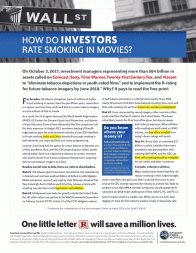November 20, 2017
The latest e-cig love fest at the 2017 E-cig Summit in England has been bouncing around the internet, so I thought it would be worth summarizing some of the evidence debunking common e-cig myths. The list of citations is nowhere near exhaustive, but illustrates why these myths are myths.
Myth 1: There is no gateway effect.
A recent meta-analysis shows 100% consistent evidence that never cigarette smoking youth who begin nicotine use with e-cigarettes are significantly more likely to progress to cigarette smoking than youth who do not use e-cigarettes. There have been several additional longitudinal studies published that have shown the same thing since this meta-analysis was published, including one from England.
There are also consistent data showing that e-cigarettes attract youth at low risk of beginning tobacco use with cigarettes and expanding the overall nicotine use market.
November 20, 2017
 This ad ran in Variety and Hollywood Reporter beginning November 21, 2017.
This ad ran in Variety and Hollywood Reporter beginning November 21, 2017.
Read the portfolio managers' October 2017 letter and screen your own mutual funds to see if they include tobacco or media companies that promote tobacco at TobaccoFreeFunds.org
View a larger copy of the ad and supporting material at http://smokefreemovies.ucsf.edu/sfm-ads/ad-122
November 18, 2017
Liza Gross just published an excellent in-depth investigation that puts the e-cigarette advocacy network, including such key players as David Sweanor, Bill Godshall, Brad Rodu, and Joel Nitzkin as well as the tobacco companies’ network of right wing think tanks that are supporting e-cigarettes in the larger context of the tobacco industry’s efforts to deny science and keep people smoking.
She also talks about how any scientist who presents data they don’t like gets attacked.
This is must reading for anyone interested in e-cigarettes and the whole harm reduction debate.
The story, “Smoke Screen: Big Vape is copying Big Tobacco’s playbook,” is available here.
November 18, 2017
Yvette van der Eijk, Patricia A McDaniel, Stella A Bialous and I just published “United Nations Global Compact: an ‘Inroad’ into the UN and reputation boost for the tobacco industry” in Tobacco Control.
This paper shows how the tobacco companies capitalized on the UN’s efforts to engage the business community in its mission. Rather than moving tobacco companies toward supporting the UN’s activities to improve global conditions, the companies co-opted the Global Compact as part of their “corporate social responsibility” public relations programs to undermine global tobacco control.
The UN recently decided that tobacco companies were not eligible to participate in the Global Compact. It is time for other UN agencies, like the International Labor Organization and UNICEF, to follow suit.
Here is the “What this paper adds” section of the paper:
► Between 2003 and 2015, thirteen tobacco companies, subsidiaries and tobacco industry affiliates joined the United Nations Global Compact (UNGC), a UN initiative to engage corporations in supporting the UN’s mission.
► In September 2017, UNGC excluded companies that derive revenue from tobacco production or manufacture from participating in the compact.
November 15, 2017
Mark Olfert and his colleagues recently published “Chronic exposure to electronic cigarette (E-cig) results in impaired cardiovascular function in mice” in Journal of Applied Physiology. In this study they exposed mice to e-cigarette aerosol for 8 months and found changes in their blood vessels that indicate heightened heart disease risk. (These results are consistent with short-term studies in humans show that people who use e-cigarettes immediately have compromised functioning of their blood vessels.) The effects were comparable to those found in mice exposed to cigarette smoke.
Interestingly, they did not find effects on lung function, which differs from earlier work.
In any event, this paper adds to the strong and consistent case that e-cigarettes use brings substantial cardiovascular risk. Heart and vascular disease accounts for around half of smoker deaths.
Here is the abstract:
